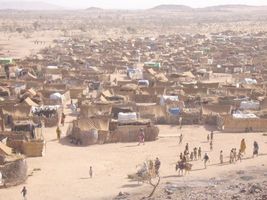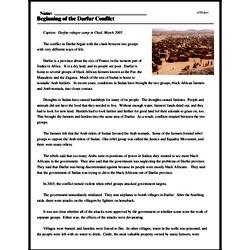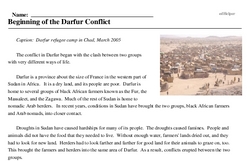Beginning of the Darfur Conflict
Caption: Darfur refugee camp in Chad, March 2005
The conflict in Darfur began with the clash between two groups with very different ways of life.
Darfur is a province about the size of France in the western part of Sudan in Africa. It is a dry land, and its people are poor. Darfur is home to several groups of black African farmers known as the Fur, the Massaleet, and the Zagawa. Much of the rest of Sudan is home to nomadic Arab herders. In recent years, conditions in Sudan have brought the two groups, black African farmers and Arab nomads, into closer contact.
Droughts in Sudan have caused hardships for many of its people. The droughts caused famines. People and animals did not have the food that they needed to live. Without enough water, farmers' lands dried out, and they had to look for new land. Herders had to look farther and farther for good land for their animals to graze on, too. This brought the farmers and herders into the same area of Darfur. As a result, conflicts erupted between the two groups.
The farmers felt that the Arab rulers of Sudan favored the Arab nomads. Some of the farmers formed rebel groups to oppose the Arab rulers of Sudan. One rebel group was called the Justice and Equality Movement, and there were many others.
The rebels said that too many Arabs were in positions of power in Sudan; they wanted to see more black Africans in the government. They also said that the government was neglecting the problems of Darfur province. They said that Darfur was being discriminated against because its people were mostly black Africans. They said that the government of Sudan was trying to drive the black Africans out of Darfur province.
In 2003, the conflict turned violent when rebel groups attacked government targets.
The government immediately retaliated. They sent airplanes to bomb villages in Darfur. After the bombing raids, there were attacks on the villagers by fighters on horseback.




